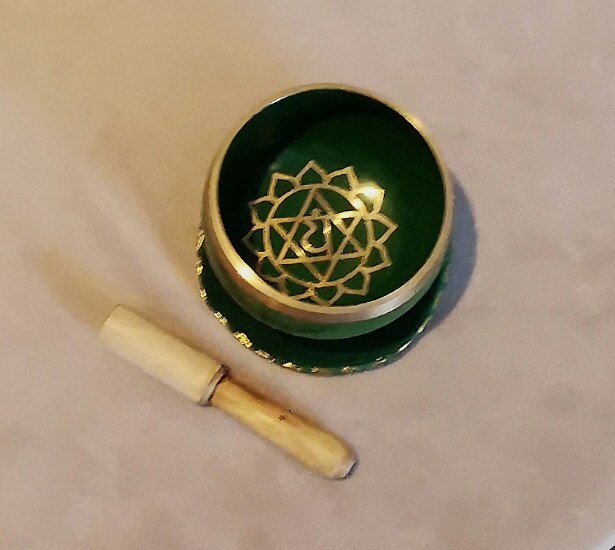The exact origins of singing bowls remain somewhat mysterious, but they are widely believed to have originated in the Himalayan region, particularly in Tibet, Nepal, and India. These bowls are often associated with Buddhist practices and were historically used by monks and spiritual seekers for meditation, chanting, and rituals. However, their use is not limited to Buddhism; they have also been found in shamanic traditions and healing practices across Asia.
Singing bowls are typically handcrafted from an alloy of seven metals, each representing a celestial body: gold (the Sun), silver (the Moon), mercury (Mercury), copper (Venus), iron (Mars), tin (Jupiter), and lead (Saturn). The craftsmanship involved in making these bowls is remarkable, with artisans hammering the metal by hand to create the perfect shape and tone. Some bowls are hundreds of years old and are highly valued for their rich, deep sound and historical significance.
Singing bowls produce sound through vibration. When struck or rubbed with a mallet, the bowl emits a harmonic tone that resonates deeply with the human body and mind. The principle behind this is similar to that of a bell, but the shape of the bowl allows for a unique, sustained resonance.There are two main ways to play a singing bowl:
Striking the Bowl: This involves gently hitting the bowl with a padded mallet to produce an immediate, ringing tone.
Rimming the Bowl: By running the mallet around the rim of the bowl in a circular motion, the vibrations build up gradually, creating a continuous, mesmerizing sound.
Each bowl has a unique frequency, and many believe that these frequencies align with the body's chakras (energy centers), helping to balance and harmonize one’s physical and emotional state.
The use of singing bowls extends beyond their melodic charm. Many people use them for meditation, healing, and relaxation, as they are thought to have numerous mental and physical health benefits.
One of the most well-known benefits of singing bowls is their ability to reduce stress. The soothing sound and vibrations help calm the nervous system, lowering stress levels and promoting relaxation. Many people find that playing or listening to singing bowls can induce a meditative state, making them an excellent tool for mindfulness practices.
Singing bowls are commonly used in meditation sessions to help individuals focus and enter a state of deep relaxation. The sustained tones serve as an anchor, drawing attention away from distractions and guiding practitioners into a peaceful, introspective space. Some meditation instructors incorporate singing bowls into their sessions to mark the beginning and end of practice.
Many practitioners of sound therapy believe that singing bowls can help heal the body by balancing energy. Each frequency produced by a bowl is thought to correspond to a specific chakra, and playing the right bowl can help clear blockages and restore harmony. While scientific evidence on chakra healing is limited, many users report feeling more balanced and energized after a session.
Some studies suggest that sound therapy, including singing bowl therapy, may aid in pain relief. The vibrations produced by the bowls can stimulate circulation, reduce muscle tension, and promote healing in the body. While singing bowls should not replace medical treatment, they can serve as a complementary practice for overall well-being.
People who struggle with insomnia or restless sleep often turn to singing bowls as a natural sleep aid. The calming effect of their sound helps to slow down brain activity, making it easier to fall asleep and achieve a restful state.
For those interested in incorporating singing bowls into their daily lives, selecting the right bowl is an essential step.
Here are some factors to consider:
Singing bowls come in various sizes, with smaller bowls producing higher-pitched sounds and larger bowls creating deeper, more resonant tones. The material composition also affects the sound, with traditional hand-hammered bowls often producing richer tones than machine-made ones.
It’s best to listen to the bowl before purchasing it to ensure that the sound resonates with you. Some people are naturally drawn to certain frequencies, and choosing a bowl that "feels right" is key to maximizing its benefits.
If the bowl is intended for meditation, a softer, more sustained tone may be ideal. For sound healing or chakra balancing, different tones may be required to match specific energy centers.
A good-quality mallet will enhance the sound quality of the bowl, while a cushion or ring stand helps stabilize the bowl when it is played.
Using a singing bowl doesn’t require extensive training. Here are some simple ways to incorporate it into daily routines:
Morning Rituals: Start the day by striking the bowl and setting an intention.
Meditation Sessions: Use the bowl to begin and end meditation practice.
Relaxation Time: Play the bowl before bed to promote restful sleep.
Stress Relief: Use the bowl whenever stress levels rise to regain a sense of calm.


